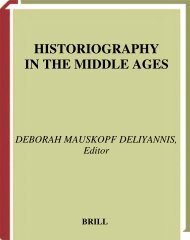02Knights Templar - Julian Emperor
02Knights Templar - Julian Emperor
02Knights Templar - Julian Emperor
Create successful ePaper yourself
Turn your PDF publications into a flip-book with our unique Google optimized e-Paper software.
SAINTS<br />
religious function for a varied number of faith groups over a<br />
very long period of time. The earliest known use of this site<br />
for religious purposes dates from the Aramean period when a<br />
temple of Hadad was built there. During the pre-Christian<br />
Roman period it became the site of a temple dedicated to<br />
Jupiter. Its function was to change again in the Byzantine era<br />
when Christianity was the dominant religion of the Eastern<br />
Roman Empire and a church was built there, importantly one<br />
that was dedicated to St John the Baptist.<br />
Following the loss of Damascus to Muslim forces in 636<br />
AD, during the reign of the Byzantine emperor Heraclius, the<br />
church built on the site was left unharmed. In fact, it was<br />
jointly used by Christians and Muslims, although eventually an<br />
extension made of mud brick was erected against the south<br />
wall of the church where Muslims could pray. This situation<br />
continued until around 706 AD when, under the rule of the<br />
Caliph Al-Walid I of the Umayyad dynasty, it was destroyed<br />
and the mosque that exists today was built in its place. It is<br />
said that the Caliph symbolically began the task of taking<br />
down the church by striking it with a golden spike. When<br />
preparations were being made for the building of the mosque,<br />
a team of workmen supposedly discovered the head of St John<br />
the Baptist. Following this great discovery, a shrine was subsequently<br />
built to house this most precious religious relic.<br />
Interestingly, Caliph Al-Walid I was aided in building the<br />
mosque by the Byzantine <strong>Emperor</strong> Justinian II who<br />
despatched a skilled team of craftsmen, large quantities of<br />
gold and materials such as mosaic tesserae to him for the purpose.<br />
Like many other mosques (and Islamic architecture in<br />
general) it consequently displays strong Byzantine influence.<br />
The Ummayad Mosque was intended for a number of functions,<br />
not only incorporating religious activities but also serv-<br />
•64•













